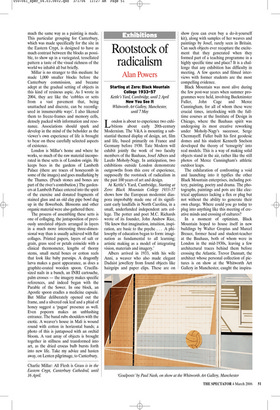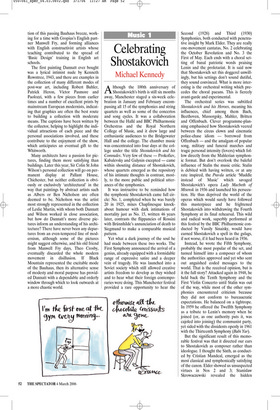Rootstock of radicalism
Alan Powers
Starting at Zero: Black Mountain College 1933–57 Kettle’s Yard, Cambridge, until 2 April Now You See It Whitworth Art Gallery, Manchester, until 7 May London is about to experience two exhi bitions about early 20th-century Modernism. The V&A is mounting a substantial themed display of design, art, film and life, based primarily on France and Germany before 1930. Tate Modern will exhibit jointly the work of two faculty members of the Bauhaus, Josef Albers and Laszlo Moholy-Nagy. In anticipation, two exhibitions outside London demonstrate outgrowths from this core of experience, supposedly the rootstock of radicalism in the past 100 years of art and design.
At Kettle’s Yard, Cambridge, Starting at Zero: Black Mountain College 1933–57 shows how the European modernist diaspora improbably made one of its significant early landfalls in North Carolina, in a small, underfunded independent arts college. The potter and poet M.C. Richards wrote of its founder, John Andrew Rice, ‘He knew that imagination, intuition, inspiration, are basic to the psyche ... A philosophy of education began to form: imagination as fundamental to all learning; artistic making as a model of integrating vision, materials and imagery.’ Albers arrived in 1933, with his wife Anni, a weaver who also made elegant Dadaist jewellery from found objects like hairgrips and paper clips. These are on show (you can even buy a do-it-yourself kit), along with samples of her weaves and paintings by Josef, rarely seen in Britain. Can such objects ever recapture the excitement that they generated when they formed part of a teaching programme in a highly specific time and place? It is a challenge that any exhibition has difficulty in meeting. A few quotes and filmed interviews with former students are the most compelling evidence.
Black Mountain was most alive during the few post-war years when summer programmes were held, involving Buckminster Fuller, John Cage and Merce Cunningham, for all of whom these were crucial times, interlocking with the fulltime courses at the Institute of Design in Chicago, where the Bauhaus spirit was undergoing its most creative reworking under Moholy-Nagy’s successor, Serge Chermayeff. Fuller built his first geodesic domes and his student Kenneth Snelson developed the theory of ‘tensegrity’ into real models. This is a way of making solid objects stand in the air, rather like the still photos of Merce Cunningham’s athletic outdoor leaps.
The exhilaration of confronting a void and launching into it typifies the other Black Mountain enterprises, including pottery, painting, poetry and drama. The photographs, paintings and pots are like electrical appliances lacking a flex or plug but not without the ability to generate their own charge. Where could you go today to plug into anything like this meeting of creative minds and crossing of cultures?
In a moment of optimism, Black Mountain hoped to house itself in new buildings by Walter Gropius and Marcel Breuer, former head and student-teacher at the Bauhaus, both of whom were in London in the mid-1930s, leaving a few architectural traces behind them before crossing the Atlantic. Trevor Dannatt, the architect whose personal collection of pictures is on show at the Whitworth Art Gallery in Manchester, caught the inspira tion of this passing Bauhaus breeze, working for a time with Gropius’s English partner Maxwell Fry, and forming alliances with English constructivist artists whose teaching contributed to the spread of ‘Basic Design’ training in English art schools.
The first painting Dannatt ever bought was a lyrical intimist nude by Kenneth Rowntree, 1943, and there are examples in the collection of many different modes of post-war art, including Robert Buhler, Patrick Heron, Victor Pasmore and Paolozzi, with a few pieces from earlier times and a number of excellent prints by mainstream European modernists, indicating that graphics are often the best route to building a collection with moderate means. The captions have been written by the collector, helping to highlight the individual attractions of each piece and the personal associations involved, and these contribute to the enjoyment of the show, which anticipates an eventual gift to the Whitworth.
Many architects have a passion for pictures, finding them more satisfying than buildings. Later this year, Sir Colin St John Wilson’s personal collection will go on permanent display at Pallant House, Chichester, but neither collection is obviously or exclusively ‘architectural’ in the way that paintings by abstract artists such as Albers or Ben Nicholson are often deemed to be. Nicholson was the artist most strongly represented in the collection of Leslie Martin, with whom both Dannatt and Wilson worked in close association, but how do Dannatt’s more diverse pictures inform an understanding of his architecture? There have never been any departures from an even-tempered line of modernism, although some of the pictures might suggest otherwise, and his old friend from Maxwell Fry days, Theo Crosby, eventually discarded the whole modern movement in disillusion. If Black Mountain represented the excitable mode of the Bauhaus, then its alternative sense of modesty and moral purpose has provided Dannatt with a dependable and orderly window through which to look outwards at a more chaotic world.











































































 Previous page
Previous page